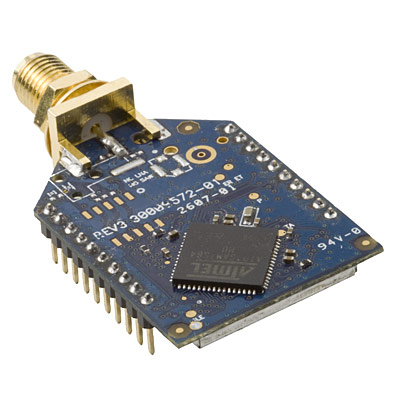One dilemma I encountered was choosing the frequencies of my data and video links. They must be different to avoid interference, but I still want the most range possible.
Early on, I considered the DragonLink system for the data link. It operates in 433 MHz bands and is designed specifically for rock-solid, low-latency RC airplane control at huge ranges. However, communication is only one-way and it's expensive at $270.
I chose to use 900 MHz for data and 2.4 GHz for video. There are a lot of cheap off-the-shelf modules available for both. 900 MHz should theoretically offer better range, so hopefully the link will remain intact even after the plane goes out of video range.
UAV 5000
Sunday, July 25, 2010
Radio selection
Range was the most important factor to me in choosing a two-way data link for the plane. Even once it's out of video range, I want to know where the plane is and be able to upload new waypoints or bring it home.
There are a few options for cheap, long-range packet modems that operate in unlicensed bands. Here are some of the models I considered:
XBee Pro XSC 900 MHz, 20 mile range, 100 mW, 9.6 kBps max data rate. Cost: $72
900 MHz, 20 mile range, 100 mW, 9.6 kBps max data rate. Cost: $72
This one is limited by transmit power but seems very good otherwise. It was a tempting option because it's common and there are accessories and code already available.
AeroComm AC4790
900 MHz, 20 mile range, 1000 mW, 115 kBps max data rate. Cost: $74
I nearly decided on the AC4790 before learning about...
RFM DNT900
 900 MHz, 40 mile range, 1000 mW, 460 kBps max data rate. Cost: $69
900 MHz, 40 mile range, 1000 mW, 460 kBps max data rate. Cost: $69
The DNT900, on paper, is obviously the winner. It also allows the user a lot of control over internal parameters, which will enable low latency and robust communication even at long range.
I bought two DNT900 radio modules from Mouser.
There are a few options for cheap, long-range packet modems that operate in unlicensed bands. Here are some of the models I considered:
XBee Pro XSC
 900 MHz, 20 mile range, 100 mW, 9.6 kBps max data rate. Cost: $72
900 MHz, 20 mile range, 100 mW, 9.6 kBps max data rate. Cost: $72This one is limited by transmit power but seems very good otherwise. It was a tempting option because it's common and there are accessories and code already available.
AeroComm AC4790

900 MHz, 20 mile range, 1000 mW, 115 kBps max data rate. Cost: $74
I nearly decided on the AC4790 before learning about...
RFM DNT900
The DNT900, on paper, is obviously the winner. It also allows the user a lot of control over internal parameters, which will enable low latency and robust communication even at long range.
I bought two DNT900 radio modules from Mouser.
Project Goals
This blog will document my progress building a homemade UAV. My main goals are:
- Extremely long range live video link- on the order of 10 miles
- Robust autopilot including waypoints, automatic launch and landing
- Simple to launch, fly, and recover - tolerant of operator error
Subscribe to:
Posts (Atom)